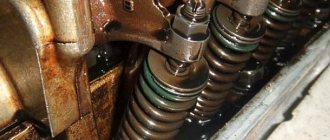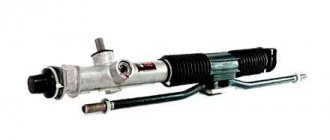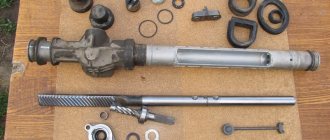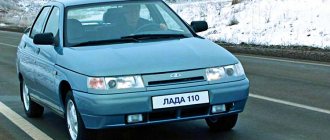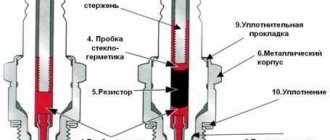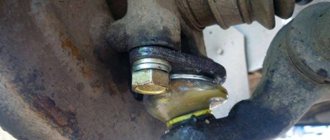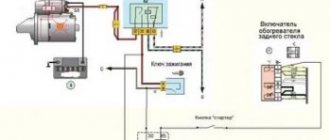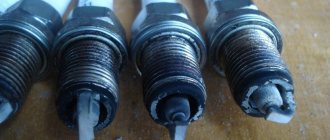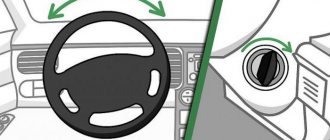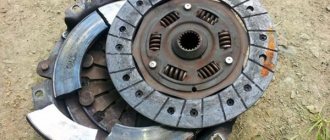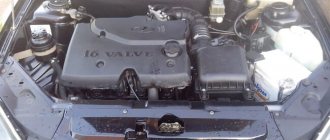If you hear a noticeable knocking noise when you move the steering wheel left to right: diagnosis
Probable Causes
If an audible knocking sound in the front suspension when turning the steering wheel indicates wear in its constituent parts, then an extraneous clicking sound when the steering wheel rocks requires inspection of other structural elements. As a rule, the problem lies in the vehicle control system.
Statistics show that there is something to knock in the “steering wheel”. Any pairing may come under suspicion:
- Gap in the fit between the steering tip and the strut.
- Excessive play in the steering rack.
- There is a problem with the steering shaft driveshaft.
- Free movement of the steering wheel on the shaft.
- Gap in steering rod joints.
These parts are present in the design of any car. Knowing the location of all the landings, it remains to identify the defective pair.
For your information. Some old foreign cars have a folding steering column assembly, which breaks under the influence of a critical load that occurs during an accident. He can knock too.
How to identify knocking: expert methods
The classic approach to identifying a faulty unit will be explained in any garage. Its essence is trivial: just ask the assistant to shake the steering wheel and at this time put his hand on the mentioned connections.
Steering rack
However, in some situations this technology loses its relevance. In particular, it will not be possible to identify a defect in the mechanism using this method. To identify a problem in the gear-rack engagement, it is necessary to carry out the following experiment:
- If there is power steering (hydraulic booster): a knocking sound appears when the steering wheel is rotated on a car with the engine turned off, but when the engine is running, there is no knocking at the place.
- There is no power steering: drive along a road section with a changeable direction - when you swing the steering wheel left to right, a knock is heard, but when turning, the rack does not knock due to the small wear of the working surfaces of the gearing in the extreme positions.
For your information. It is not recommended to tighten a worn rack. One of the owners of Hyundai Solaris performed this procedure and after 10,000-12,000 km the steering wheel began to bite. An autopsy showed that the mechanism was beyond repair.
Emergency system
It is also possible to determine experimentally whether the steering column folding assembly is the cause of the knocking. It is enough to swing the “steering wheel” to the sides, while simultaneously pressing it to the bottom. The sound disappeared - the problem is in the emergency system.
How to eliminate a knock in the steering rack
Knocking in the steering rack can only be eliminated in one way - by carrying out repair or maintenance work. Further steps will be relevant only after complete and accurate identification of the source of the knock, otherwise the work will be in vain.
So, the most vulnerable areas of the steering wheel are: bearing, block, bushing, boot, rack gear mechanism. When carrying out visual diagnostics, many defects, prerequisites, and breakdowns may not be visible due to their secrecy. A complete disassembly of the mechanism is required.
To carry out complete dismantling, you will need, regardless of the make of the car:
- set of tools;
- a portable lighting lamp if work will take place in low light conditions;
- repair kits for gaskets for the body part of the rack;
- crackers, bushings, seals;
- lubricant, sealant;
- new bearings, provided that the old ones have failed.
Other equipment or fixtures may be required.
Regardless of the model, the algorithm is built like this:
- the steering mechanism is dismantled, the fastening connections are unscrewed;
- hydraulic pipes or an electrical circuit board are provided for different types of steering;
- The clamp is removed from the interior of the car - the connector between the guide rod and the steering wheel itself;
- The product is removed, placed in a vice, visual diagnostics are carried out, and a complete disassembly is carried out.
Based on the data obtained during the analysis, a decision is made on the need to replace a particular part. At the end of disassembly, all parts must be washed and dried. Only after this proceed to assembling and installing new equipment. Be sure to follow the sequence of actions. This is very important to ensure the performance of the part during future operation. Do not forget to lubricate each installed mechanism with graphite lubricant, if it requires it.
What causes a knocking sound in the front suspension of a car when turning the steering wheel while driving?
The chassis and steering mechanism are tightly coupled and perform a single function. One rack command is not enough to turn the wheels in one direction. The racks, which are connected by tips and rods to the rack and pinion assembly, must not only absorb shock, but also rotate around their own axis. This became possible with the introduction of movable mounts.
What's causing the knocking?
When there is a knocking sound when turning the steering wheel while driving, but no extraneous sounds are observed in place, we can firmly state that there are problems with the suspension. Its design includes a sufficient number of connections that use bearings. Any support gradually fails, as evidenced by increased play.
- Strut support bearing.
- Spherical bearing.
- Wheel bearing.
How to identify tapping
You can calculate the knock in the front suspension of a car when turning the steering wheel experimentally. The work is carried out both on site and while moving - it all depends on the location of the defective area:
- The support bearing is checked by rocking the body to the sides: the hand lying on the “support” holder should not feel any play. The second diagnostic method: grab the front wheel spring and ask an assistant to rock the steering wheel to the sides - there should be no knocking.
- A metallic clatter will be heard in the worn out “ball” when bent with a pry bar.
- The hub support makes a dull knock when turning the steering wheel at small angles at a speed of 50-60 km/h.
Communities › Volkswagen Club › Blog › Steering rack or linkage knocking?
passat b6 2006 The knocking noise occurs when the steering wheel is turned left and right quickly. especially on the pits it rattles
Comments 52
hi what is the result of rack or traction
It's the rack that's knocking, I went through this on an Audi, restore it before it's too late.
I think it's not too late
Also check the condition of the threads on the tie rod.
Tie rod end
Something similar is happening to me, almost depending on my mood, there is a knocking noise when you turn at low speeds, and when you stand still (but not always). When turning the steering wheel, in some places you can actually feel something hitting the steering wheel. I still don’t understand, and I don’t have time.
Isn't that a rack support? I had a knocking noise when I turned the steering wheel. They sentenced the rack support. I replaced both and was happy. There were still wires on the polo.
2 front springs are broken at the very top. Probably the support bearings also bent. but they don't crunch. Probably the load was heavy and the rack began to knock
The knocking noise may be due to a lack of power steering fluid.
I don't have a guru
find the reason by elimination: Knock out the tip, check - it should be tight, and when lifting up, the rod should stand under its own weight or, at a minimum, slowly fall down (do not fall)
The same crap appeared after touching the subframe, especially when it was cold.
why touch the subframe?
rack most likely
So if the steering wheel doesn’t bite when driving, or something else it does, then it’s definitely not the rack. And in general, the rack can’t be checked without the engine running. What’s wrong? Any car has a slight knock when you jerk the steering wheel. When driving, does it make a noise in the steering wheel? Or is it just a knock?
one hundred said rake. They said that if you take it off, you might not be able to attach it. Is this true? is it adjustable and tightened without removal?
there is a bolt for shaking. But from personal experience I will say that doing the rack is the last thing. I had a similar situation, I didn’t know where the knocking came from, the suspension was fine... they said it could be the rack. In the end it’s ball joints. I would advise you to listen to the previous adviser and look at the supports. Usually, if a support fails, the spring starts to bite, and then there’s a crunch
the noise is coming from the rack. You can hear a strong ringing.
Then I don’t understand why you raised the topic if you know for sure...
I found out for sure the next day when I decided to stop by a hundred
Yes. The steering wheel is knocking.
As far as I understand, the car is jacked up, but there is no need to look for a fault. Grasp the pull, if this pull knocks you will feel it. You need to look at the engine running while the engine is running and on the wheels, or better yet, by unloading the entire front axle, or on a lift...
The wheels are making even more noise
As far as I understand, the car is jacked up, but there is no need to look for a fault. Grasp the pull, if this pull knocks you will feel it. You need to look at the engine running while the engine is running and on the wheels, or better yet, by unloading the entire front axle, or on a lift...
There should be an electric rail here.
one hundred said rake. They said that if you take it off, you might not be able to attach it. Is this true? is it adjustable and tightened without removal?
The aluminum liners in the rack mechanism become sour...thanks to the springs, these liners are pressed against the rack rod...if the liners become sour...you get this knocking noise...I wonder...if you start the car...the sound will be less?
one hundred said rake. They said that if you take it off, you might not be able to attach it. Is this true? is it adjustable and tightened without removal?
Ideally...of course, remove the rack...I repair without removing...The main thing: when removing it, don’t break the cable (it’s plastic)...just be careful...You need to find a service station that will repair the rack and, most importantly, they will give a guarantee for their work...
250 bucks complete kit with removal and installation. I don’t know what to do yet. They write that they tighten it and the play goes away and they write that they re-glue the textolite inserts on the pistons, clean it, lubricate it and it works like new. I can do all this, but for how long and the main question is about tying it up. I can not understand! I pulled out the mechanical part and put it back in. What kind of binding is there. As I understand it, if you tie another rail to the brains. If I remove the rail and put it back in, will it work?
After such a repair... the steering rack will work for another 100 thousand and you won’t know grief... The question about coding or binding is due to the fact that when removing the steering rack, all connectors from it are disconnected. And maybe it would lose that same coding... During my work... this happened once... and after the painstaking work of a competent electrician everything worked... this is an isolated case... Do it and don’t worry :) True... the price of the issue is 8000₽
why did she lose? If you turn off the battery, then everything will be fine, I think. brains are turned off
Quick Guide
The main reason for tapping is the formation of a gap in the joints. In the steering system, there may be knocking on the tips, ball joints of the rods, the rack, the “cardan” in the column, the steering wheel on the shaft, or the auto-folding system in case of an accident. The metallic sound is distinct and can be heard in place when rocking the steering wheel.
It is quite possible to mistake problems in the suspension for problems in the steering, since the initial stages of wear of bearings and supports only make themselves felt when cornering at speed. In the suspension part, the cause of the knock should be sought in the wheel bearings, ball joints and “supports”.
Car owners often encounter a problem: when turning in one or both directions, an unpleasant and disturbing sound is clearly heard. There may be several reasons. To independently find and eliminate the malfunction indicated by a knocking sound when turning the steering wheel, you need consistent diagnostics of the chassis.
Almost every driver has encountered a knocking sound when turning the steering wheel.
What can precede the appearance of a knock?
The knock may be preceded by various deviations:
- The appearance of gaps (play) between the parts of the steering mechanism. Different parts of this mechanism begin to collide with each other. In this case, it is important to understand that it is not the knocking itself that will pose a serious danger, but the potential unpredictability of the vehicle when entering a turn on the highway.
- Spontaneous rotation of the steering wheel.
- Increased sensitivity of the vehicle. The car begins to “throw” to the side when the steering wheel is turned slightly, or dissonance occurs between the angle of rotation of the vehicle’s wheels and the angle of rotation of the steering wheel.
- Drop in fluid level in the power steering reservoir.
- Hydraulic fluid getting into the linkage boots.
Poor-quality road surfaces, negligent attitude to maintenance (especially power steering, if equipped), and installation of wheels on a vehicle that do not meet the requirements recommended by the manufacturer can increase the risk of rack breakage and knocking.
Preparing for diagnosis
You need to start by trying to determine the location and nature of the sound. A clear and loud knock in the steering wheel is generated by the impacts of metal on metal, while a muffled knock is generated by metal on plastic. Check the tire pressure: their difference can also cause noise.
Before inspection, you need to clean the front suspension, the easiest way is with a powerful jet of water. After it dries, you can put the car on a pit or viewing platform. There you need to wipe the parts dry with a rag and, if necessary, clean off dried dirt or rust with a brush. Among other things, this way you will save yourself from sand falling from above.
When preparing to diagnose the suspension, you should pay attention to the tightening of the threads, rubber cushions and boots.
Repair of Lada Kalina steering wheel
The Kalina steering rack, like any other model of the domestic automobile plant, can exhibit knocking noise when operating on uneven surfaces. In addition, when driving, shocks are transmitted to the steering wheel. Before carrying out repairs, you need to figure out why the steering rack is heard. The Lada Kalina may make a knocking noise due to a loose adjustment screw or severe wear and tear and improper operation of the car.
To adjust, you will need keys 10 and 13, as well as a puller for the steering wheel. To do this, there is no need to drive the car into a pit or onto a lift. All operations are carried out directly in the engine compartment.
To adjust the rack, it is necessary to remove the battery, since its location interferes with the work being carried out. Using a 10mm wrench, remove the terminals, and using a 13mm wrench, unscrew the battery fastening tie.
After removing the battery, you need to remove the stand underneath it, which is secured with 4 bolts. This will allow full access to the steering rack. On the bottom side of the housing there is an adjusting bolt with an internal plastic cap, which also needs to be removed. After these procedures, you need to tighten the traction using a special key.
Identifying possible causes of knocking
Turning the steering wheel of front-wheel drive cars involves many joints, levers and rubber seals. A knocking sound in the steering wheel when turning may indicate wear of components or parts.
First of all, the assistant can turn the steering wheel, and you can listen to sounds under the car. Sometimes it is difficult to determine a breakdown by hearing, so you can touch various parts with your hand.
Wheel arch protection
One of the common causes of knocking is loosening of the wheel arch protection. In this case, it first turns under the action of the wheel, then returns to its original position, which gives rise to a characteristic “plastic” sound. Reliable fixation of the plastic protection takes a few minutes.
Hinges
Knocking when turning wheels can be generated by hinge joints: steering tips and rods, earrings and stabilizer rods. The noise occurs when a dirty or unlubricated joint jams. Sometimes it is enough to lubricate it, sometimes it is necessary to replace it.
A metallic crack that accompanies a full turn of the steering wheel may indicate a breakdown of the constant velocity joint, or in popular parlance, a “grenade”. A cracking sound when turning in both directions means that both “grenades” need to be replaced. Failure of CV joints is usually associated with a rupture of the rubber boot that protects the mechanism body. Even a small tear is enough to create the need to replace one of the most expensive components of the chassis. Therefore, it is better to check the anthers once a month for damage.
Silent blocks and ball joint
Noise can be caused by heavily worn-out rubber silent blocks and ball joints. In this case, when the wheels turn, the lever becomes skewed, which generates the sound.
Front pillar
If the steering wheel of a stationary car knocks when turning, then very often this means a breakdown of some part of the front strut. Some of these faults can be found directly, others can be found by dismantling and disassembling the rack.
Symptoms of malfunctions
If you do not pay attention to the wear of the tie rod ends, the ball pin will become loose and jump out of its socket at the first decent bump. There is no need to explain for a long time what this entails: the wheel will become uncontrollable, and the driver will lose control of the car. How to determine that there are problems with the hinges and the car’s chassis needs to be checked:
- the first sign is a dull, frequent knocking sound when driving over small bumps, especially in turns;
- as a rule, extraneous sounds are heard from one side, but simultaneous wear of two tips also occurs;
- the free play of the steering wheel increases;
- when negotiating a turn on an uneven road, you can feel a tapping sound on the steering wheel;
- At the last stage of wear of the tips, the car has to be literally “caught” on the road, since due to the play of the ball pins, the wheels can deviate by 2–3° from the straight line.
Note. Unfortunately, such signs are observed not only as a result of problems with the steering rack, but also as a result of wear of the bearing of the rotary bipod and the pendulum. The exact result will be shown by a check performed by car service employees or independently in a garage.
If you find one of the listed symptoms in your own car, you should not delay diagnosis. Especially if the tips have served more than 40 thousand kilometers. To perform the check, you will need an inspection ditch; hanging the car on a jack will not allow you to swing the rod in the desired direction.
To check the tie rod ends yourself, use the step-by-step instructions:
- Drive the car exactly in the center of the inspection hole so that you can easily reach the hinges. If the ditch is too narrow, the car will have to be moved twice in different directions.
- Support the rear wheels with wheel chocks.
- Grab the rod with your hand as close to the tip as possible. Rock the hinge up and down to feel the play.
- A small elastic resistance indicates that the spring is working and there are no critical gaps. Significant play is felt immediately.
- Rotate the rod several times around its own axis. If it flows easily, literally dangling on the ball pin, the tip should be replaced.
Front suspension repair
The cost of the parts themselves when eliminating the described reasons is most often small, but the price of replacing them in car services sometimes causes bewilderment. In such cases, it is better to repair the suspension yourself. This requires special devices and tools.
To remove the tips and ball joints of the steering wheel, pullers are needed that, during dismantling, preserve the integrity of these parts.
Silent blocks are replaced using a long threaded rod or bolt with a corresponding nut and a set of bushings and washers. The bushings should rest on the lever cage, and the washer should match the diameter of the rubber seal. Tightening the nut squeezes the silent blocks out of the lever, and then presses a new one in its place.
Dismantling the shock absorber strut is done with two ties that compress the spring. This makes it possible to unscrew the mounting bolts, remove the support bearing and remove the shock absorber and spring. The new spring is also completely compressed by the ties, then the entire assembly is assembled.
A knock when turning the steering wheel should not make the driver nervous. However, as soon as you have time, you should immediately start troubleshooting the problem. Today on the Internet you can find videos from professional craftsmen and amateurs about repairing suspensions of different car models and for various malfunctions. It is better to spend time studying their experience and then repair everything efficiently and quickly.
The steering, along with the car's braking system, are the most important elements that ensure safe driving at any speed and on any road. Therefore, when knocks, clicks and other extraneous noises begin when turning the steering wheel, in any case, you need to sound the alarm and immediately look for the cause of the problem in order to eliminate it. Now we will tell you why a knocking sound may appear when turning the steering wheel while standing still or in motion, and what problems does it indicate?
First of all, you need to clearly localize the place where the knocking is heard, as well as determine the conditions under which it occurs, this will greatly help you in finding the breakdown, the symptom of which is the knocking. In addition, different steering systems may knock in different situations and such a knock will indicate different breakdowns. We list the main causes of knocking when turning the steering wheel:
- wear of the constant velocity joint;
- wear of the ball joint;
- wear of the support bearing of the stabilizer link;
- wear of steering tips;
- the appearance of play in the steering rack and leakage of working fluid from it;
- loose steering wheel nut;
In principle, these are the most common causes of knocking and other noises when turning the steering wheel. But there are also less common breakdowns that cause similar sounds. But we can talk about such special cases only using the example of a specific car model in which such knocks began.
Advice from professionals on using the steering rack
1. Contact only professionals
“It is possible to study a faulty steering rack and localize the location of knocks only with the car raised, and specialized equipment will be needed. This is true both for the now obsolete worm and screw steering mechanisms, and for the rack and pinion steering mechanisms that are widely used today. Only an experienced professional can find the culprit of extraneous noise.
In some cases, the problem can be solved by simply tightening the loose fastener. Do not underestimate the importance of a qualified approach to the question of how to remove knocking in the rack. Therefore, it is better to definitely contact the appropriate service stations!”
2. Tips on how to extend the life of the steering rack
- make sharp turns as little as possible;
- refrain from sudden braking and rapid acceleration;
- When parking, it is better not to reach the curb than to hit it with your wheels. Side impacts are the most painful for modern types of suspension;
- unevenness, potholes and potholes on the road must be driven through as carefully as possible;
- beware of unmarked speed bumps; hitting such obstacles is one of the main reasons for steering rack failures, according to service station workers;
- do not neglect the prevention of the steering mechanism and the entire front suspension as a whole;
- pay special attention to the integrity of oil seals, anthers and other protection. If the slightest damage is detected, do not hesitate to replace it, as this is much cheaper than potential repairs.
If you detect changes in the behavior of the car on the road, the appearance of new noises, creaks, knocks, immediately search for the reasons that caused this phenomenon.”
Tie rods and tie rods
If the tips or the tie rods themselves begin to knock, as a rule, they have to be changed. As for the diagnosis of these elements, experienced drivers carry it out independently. To do this, you need to wobble the tip and the rod itself, but you need to know how, what, and in what direction to wobble. If the steering tips or steering rods are knocking, then in the first case, replacement is required, in the second, options are possible, for example, replacing the steering rod silent blocks. But it is very likely that the thrust will still have to be changed.
With significant wear, the ball joint of the wheel can also generate extraneous sounds when turning the steering wheel. The most important element for long service life of ball joints, as well as CV joints and steering ends, is regular inspection and replacement, if necessary, of their boots. It is the anthers that protect these components from dirt, water, lubricant leakage and other negative phenomena. And if you change the boots on time, both ball and CV joints, and actually the steering ends, last quite a long time.
When is it time to change tie rods and ends? The main signs of breakdowns
Sometimes we drive a faulty car and put up with it, without even knowing about the presence of a breakdown. This is unsafe, since the manufacturer has provided complete protection against unexpected reactions of the car on the road only if everything works efficiently and properly. Therefore, you should carefully monitor the main components of the vehicle and do not forget that sometimes the car needs repairs. Otherwise, you will greatly regret that you did not make a high-quality diagnosis and did not replace the part on time. Many accidents in Russia occur precisely because vehicles have not been serviced for years. Every year it is worth undergoing a complete diagnostic of the chassis and steering at least once. It would also be useful to diagnose the power unit for sensor errors and various software glitches in the firmware.
But the most important components for safety remain the steering and braking system parts. Today we will touch on the first system - the steering of the car. The problem is that the gradual failure of most parts of this equipment is not always noticeable to the driver. Nothing knocks or rattles, or makes any other extraneous sounds. But the functionality of the elements gradually changes, and problems begin that are extremely difficult to find and eradicate. On almost all cars older than 5 years, after driving on Russian roads, the steering requires gradual, high-quality repairs. In particular, rods and ends fail and begin to change the characteristics of the steering. Of course, this leads to dangerous situations and other troubles. Today we will figure out when to change these parts?
Content
- Self-diagnosis of rods and tips
- Signs that your steering system needs urgent repairs
- How to choose good spare parts for the steering system?
- Is it worth replacing parts of the steering system yourself?
- Let's sum it up
Steering rack
If your steering rack starts knocking, this is a very unpleasant surprise. Because repairing a rack is not a cheap pleasure, and most importantly, it is quite complicated. To prevent this from happening, you need to check the condition of the oil seals from time to time, which, when they begin to leak, the working fluid leaves the rack and the wear of its parts, in particular the guide bushings and gears, occurs very quickly. Therefore, it is simply necessary to monitor the integrity of the steering rack oil seals.
And it happens that the cause of knocking when turning the steering wheel, both in place and while moving, is wear on the steering column cardan. In this case, this part simply needs to be replaced.
What can I do to make the steering rack stop knocking?
If the tips are to blame, then repairs will not be very expensive at any auto repair shop. It is better not to do this work yourself if you do not have the skills and tools. You can only adjust the wheel alignment yourself.
If the knocking comes from the side of the connection between the steering rack and the rod, then you can eliminate the defect with your own hands. The sequence of this procedure:
- Remove the protective boot and remove the grease.
- Replace the bushing if it is damaged. The fact is that this part is made from fluoroplastic, which is a rather soft material, so such a defect occurs often.
- Clean the spring from dirt and sand; if necessary, remove it and wash it with a special liquid or solarium.
- Replace the boot even if there are minor cracks or tears.
- Tighten the bolt that controls the movement of the bushing. It should be remembered that there is no need to apply much force, otherwise the entire mechanism may be damaged.
Finally, assemble all the steering components and check how it works; if the knocking noise disappears, then everything is normal, and you have saved about a hundred thousand rubles. If the rack itself is damaged, it will have to be replaced.
Other causes of knocking noise when turning the steering wheel
These reasons include different degrees of wheel inflation, which due to inexperienced drivers is not so rare. In addition, in rear-wheel drive cars, the cardan may knock and problems should be looked for in this unit. However, first of all, you need to check the above components, because most often they generate extraneous noise when turning the steering wheel.
If we summarize all of the above and give advice to beginners, we can say that a very important and effective prevention of the appearance of extraneous noise in a car, as well as the breakdowns that give rise to these noises, is to care for the car, regularly inspect it not only from the side and from above, but and from below, as well as careful and reasonable driving, especially at speed, especially on our roads. In this case, you will be able to drive for a long time and no extraneous noise will bother you. Although, of course, in due course you will have to change the steering tips, ball joints, CV joints and other components and assemblies of the car, because, alas, nothing lasts forever in this world.
How does the steering linkage knock?
We kindly request, before entering the conference and opening a new topic, look for the answer to your question here: LINK 1, here: LINK 2 and here: LINK 3 I am sure that you will find 90% of the answers using the links provided. Also - try searching from the MAIN page of the site - there may be more complete results there!
PS If you know the error code, then simply “drive” it into the search bar. And please note that the first letter of the code must be typed in the “Latin” layout! Otherwise, the search results will not take you anywhere. The first letter of the code is NOT the Russian letter “P”!
And one more thing - a HUGE request to write in this forum in RUSSIAN - save Albanian for the smoking room.
Chrysler Club Member
The second week of sweet idleness on the shore of the Azov Sea (in Yeisk) is yielding results. The brains have atrophied.
Therefore, I appeal to the collective wisdom! I need advice on what to do, what to pay attention to, etc. adviсe. Maybe there is a smart master nearby.
So, on the road from Moscow to Yeysk, 500 kilometers from home, my Caravan 2005. There were knocking noises from the front, on the driver's side. I got to Yeisk well, and I’m still riding like this, but I’m still worried about the 1300 km return road.
I went to local services, they are of no use, they call the problem and look into your eyes trying to understand whether you got it right or not. After visiting them, I begin to understand some of the reports about the absence of “masters” away from large cities.
But still one problem was found 100%! The boot of the “driver’s” steering linkage is torn! (it’s almost dry inside, the liquid doesn’t leak, and there are no traces of ATF under the car).
In the pit, after jacking up only the driver’s side, they used a pry bar to probe the chassis, balls, stabilizers and steering ends (although I don’t know how much they understand, but I think they would have noticed the “crime” at all). The jack was removed, I rocked the car, and the mechanic “felt it with his hand” under the car. there was a knock in the rack, and rendered a verdict that the steering rod was knocking in connection with the steering rack; it was when the car was rocking that a knock was heard, but when you rocked the steering wheel left and right (with the car turned off), nothing was heard, and the master “felt” nothing.
Tie rod ends knocking
Either one tie rod end or both can knock. Let's try to diagnose this malfunction, understand its causes and solutions.
Signs of malfunction: knocking tie rod ends
A failed tie rod end produces a small, repeating knock from the side of the wheel when the vehicle moves on an uneven road (crushed stone, ridges, holes, etc.). The knock is clearly audible and felt on the steering wheel. When driving on a flat road there is no knocking of the tips.
The knocking of the tips can be confused with the knocking of the anti-roll bar struts or the knocking of the steering rack. Therefore, for an accurate diagnosis, it is necessary to carry out a check.
Causes of tip knocking
The plastic liner located inside the tip body can be destroyed if dirt and moisture enters, or (the boot is torn) if the car is frequently used on bad roads, or the suspension is hit when driving through potholes and uneven surfaces. A similar effect will occur after installing a low-quality part, the service life of which may expire almost immediately.
When the liner is destroyed, the ball pin of the tip begins to “dangle” in its body, causing a loud knock. The greater the destruction of the liner, the more noticeable the knock.
Checking (diagnosis) of faulty steering tie rod ends
The easiest way to check the tie rod ends is to place the car on a level surface and grab the sides of the wheel with your hands. We pump the wheel away from ourselves and towards ourselves. If a certain amount of play is felt when the wheel rocks, the tip is faulty. You can check for play in the tip using a mounting tool as shown in the image below.
Checking the play in the steering end
More complete and detailed methods for checking tie rod ends are described on the page: “Checking tie rod ends.”
Replacing faulty tie rod ends
Replacing a faulty tip can be done using a special device, or without it (using a hammer and a pry bar). Read more: “Replacing the tie rod end.”
Disconnect the tie rod end using a pry bar and a hammer
Notes and additions
— The tie rod end of VAZ 2108, 2109, 21099 cars is a ball joint. The tip finger is made in the form of a sphere on one side and a threaded part on the other. The sphere is rolled into the tip body. The body has a plastic insert pressed against the sphere by a spring. The hinge is sealed with grease and covered with a boot on top. When the liner is destroyed, a play appears inside the hinge, which causes a knock when a load appears on the tip.
— The service life of tie rod ends on VAZ 2108, 2109, 21099 vehicles is up to 20 thousand kilometers (depending on the quality of the part and operating conditions).
— To maintain the tips in working condition for as long as possible, it is recommended that when installing new parts, additionally add a little lubricant to the boot and constantly check the condition of the boots.
